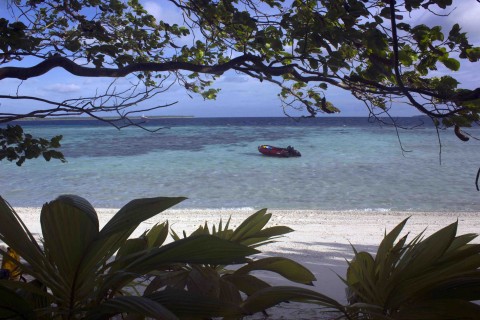BIOT MPA Survey Expedition 2015 - Day 6 - Ile du Sel, Jacobin, Boddam, de la Pas

In August last year the rat eradication effort on Ile Vache Marine in Peros Banhos had some left over bait and decided to use it to good effect by trialling eradication in the Salomons with Ile du Sel and Ile Jacobin. So we perused these two islets with the Trekker this morning. Both islands are small and can be walked around in the space of 10 minutes. They are beautiful though with white coral sand beaches and fringing palm trees. It would certainly be worthwhile to know that the rats had gone and the islands may once again see seabirds coming here to nest – time will tell. We didn’t see sign of rats on either of them.
What I did witness on du Sel though was a Morey Eel catching a crab in the shallows at my feet as I was walking. The eels in the rock pools here will pursue the crabs out of the water and over the rocks and in this instance a crab that I had disturbed strayed into a pool with a lurking eel. It was no contest. The eel tied itself in knots to gain purchase on the crab and it was torn to pieces and swallowed in the space of 30 seconds.
The eel would have far more of a job making a meal of the coconut crabs we saw on Ile Jacobin. Some really big individuals make this small island their home. We saw them as we did a Trekker transect through the centre of the island. Remarkable that such a small strip of land can support such large crabs.
Next we visited Ile Boddam with our Connect Chagos graduate Nadine so that she could see the old plantation buildings and church there. The waters of the lagoon side of Ile Boddam are perhaps the most sheltered of the Chagos Archipelago and the coral gardens there are quite spectacular. Beautiful to view as we motored slowly in towards the island. After a brief visit we took a break for lunch before heading over to Ile de la Pas at the entrance to the lagoon of the Salomon Atoll.

The white sand beaches running down into the water lend this island a picturesque appeal as the beaches turn to turquoise where they run into the water. The island itself proved to have quite a diversity of vegetation as we did a transect through it’s middle. Palm groves, hardwood stands, grassy patches and stands of fern alternated as we traversed from the lagoon shore to the Oceanside.
After all of these island visits we finished the day late. Back on board the research vessel the Shallow Catlin Seaview Survey team reported seeing the amazing coral growths within this lagoon. As the waters inside the atoll are so sheltered the corals grow into some huge complex formations. Quite different from the smaller more weathered corals that grow on the Oceanside.

